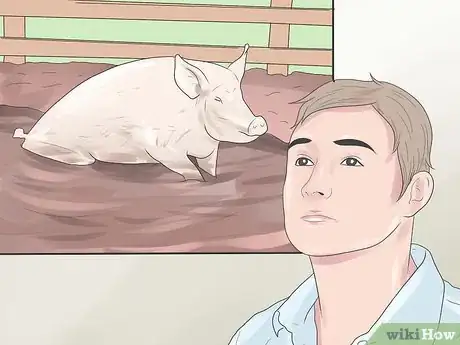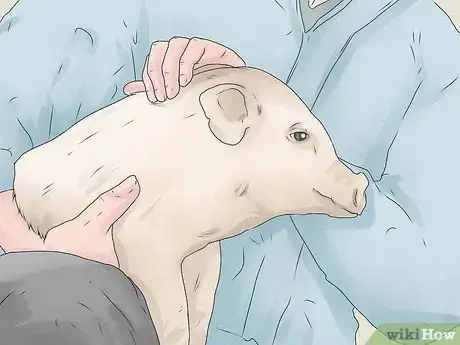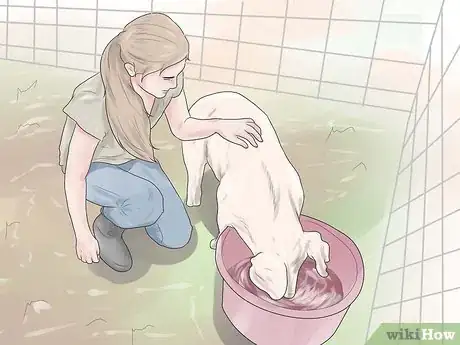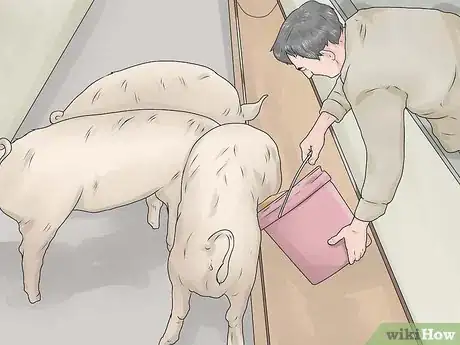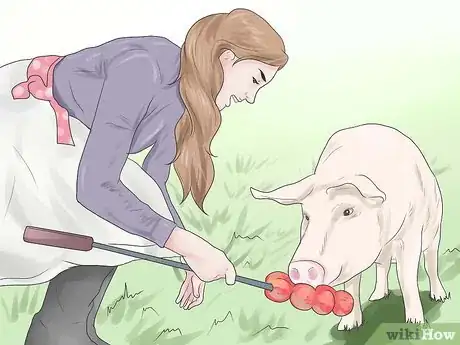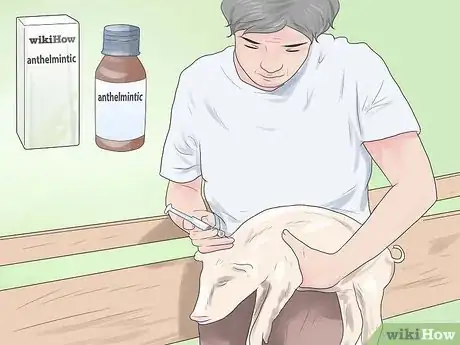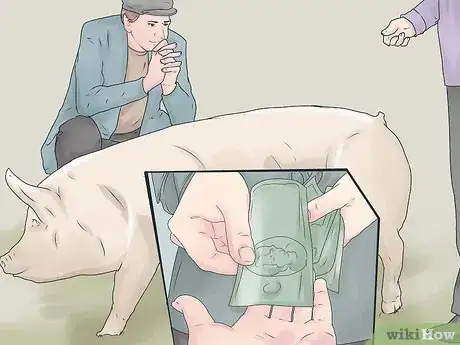wikiHow is a “wiki,” similar to Wikipedia, which means that many of our articles are co-written by multiple authors. To create this article, 34 people, some anonymous, worked to edit and improve it over time.
wikiHow marks an article as reader-approved once it receives enough positive feedback. This article received 38 testimonials and 100% of readers who voted found it helpful, earning it our reader-approved status.
This article has been viewed 642,922 times.
Learn more...
Whether you are planning on raising pigs to be sold for their meat, or to be kept as pets, you will need to know how to house them and care for them. Pigs are valuable animals for their meat and their manure. The rise of the organic eating movement has made consumers more aware of where their meat comes from, and many of them prefer buying from small, local producers than large corporate farms. Scroll down to Step 1 to learn about the process of raising pigs.
Steps
Housing Your Pigs
-
1Build a pigpen. Pigs need a dry, secure place to live that will protect them from the weather and provide enough space to move around. Some people claim that a full grown pig only needs about 20 square feet of space. However, for a truly healthy pig, you should allot each pig about 50 square feet of space.[1] When planning your pigpen out, remember that it is best if the pen is twice as long as it is wide.
- When making your plans, also keep in mind that pigs tend to relieve themselves near their water supply. Because of this, you should plan to put the water supply on the far end of the pen, away from their food and shelter.
- If you have a barn with empty stalls in it, you can consider raising your pigs inside the barn. Just keep in mind that you will have to haul the manure they produce out of the barn.
-
2Install a sturdy wire fence around the pen. Use a woven fence that is "hog tight" with a board on the bottom to discourage digging. The best way to build your fence is to map out the area you will house your pig(s) in and then build a sturdy wooden fence around the area. When your fence is built, attach 4×2 welded wire to the inside of the fence so that if the pigs push on it, it won’t go anywhere.[2]
- A movable electric fence is a good option for pigs that will be used to pasture other parts of a farm or land, and will be herded in and out of the pen.
Advertisement -
3Include at least a partial shelter. Pigs can sunburn if they do not have protection from the direct sunlight in hot weather. In cold weather, pigs will seek protection from cold and wind. The best setup is a three-sided, roofed structure that can be placed inside the fenced in area. Many pig farmers recommend that you provide your pigs with at least 15 to 20 square feet of shade. The roof doesn’t need to be higher than four feet tall.[3]
- Remember to leave a partial opening under the eaves of the structure so that heat can escape during the hotter months of the year.
- One way to provide shade is to secure shade cloth to the top of the pen to block sun.
- In the winter, you should put hay down inside the shelter that your smaller pigs can warm themselves in.
-
4Consider providing your pig(s) with a mud wallow. It's true - pigs love mud. Pigs have a hard time regulating their temperatures, and when faced with a high heat, a mud wallow looks just like a swimming pool to your piggies. To build a mud wallow, section off one part of the pen. You can build a low lying fence or trough to keep the mud in just one section. Till up the earth where your mud bath will be and then add water to the area once or twice a day (perhaps more if you live in a particularly hot climate).
- Place fresh layer of sand at the bottom of your wallow when you first dig it.
- Add fresh dirt when needed.
- Note that you have to keep the wallow clean as some pigs will use the wallow as a bathroom.
- Do not toss food in the wallow, keep it filled with water and to reduce flies and possibility of illness, do not throw food in it.
- Mud also helps reduce the risk of pigs getting lice, allows them to root (dig up the ground; something they really enjoy doing) and keeps their skin in good condition.
- Pigs will stress in heat and this can trigger heat related heart attacks. If you do not have room for a wallow, then use large kids' play pools for pigs to lay in.
-
5Figure out what you’re going to do with all the manure. A 100 pound pig can produce about 1.6 pounds of manure per day. You can use this manure to fertilize your garden or crops. You could also consider selling the manure to other local farmers or gardeners who may not have a ready supply.
-
6Control the flies. The one issue that folks have with pigs, farm pigs or pot belly pigs,is the issue of flies. After cleaning up after the pigs, cover the urine spots with a thin layer of garden lime. You can get it in bulk from garden supply stores and use a coffee can to broadcast it over the soiled area. This sweetens the area and kills fly eggs. If you are using manure for your yard, you can treat the manure pile with it as well.
- Garden lime is used to mark lines on football fields so its safe for humans and pets. In fact it’s the main ingredient in Sweet PDZ used to freshen horse stalls.
- If you can't find lime, you can use gypsum, but it won't smell as fresh.
Raising the Pigs
-
1Consider the time of year that you buy your piglets. Pigs grow in size best during warmer weather (60 to 70°F is ideal). If possible, begin your pig raising project in early spring or in late summer--this way, when the piglets are growing the most, they will do so in the best conditions. Surprising as it may sound, a 50 pound piglet, if given access to constant food and water, will grow the 250 pounds (market weight) in approximately 100 days. Talk about a growth spurt.
-
2Purchase your pigs. Whether you are raising your pig as a pet or for meat, you will need to select a healthy pig from a good breeder. Unless you have money to spare, you should focus your search to pig farms in your area that have piglets for sale. When looking at piglets, avoid buying any that are scratching or coughing. If you notice that 20% or so of the pigs at the farm you are visiting look sick, you should consider purchasing a pig somewhere else.[4]
- Keep in mind that if you go to a pig sale where multiple breeders are showing their pigs, the pigs will probably be rather stressed out. They also become more susceptible to sickness.
-
3Provide your pig with enough water. Pigs drink a lot of water. On average, they will consume 2 to 4 gallons (7.6 to 15 l) of water per day. Keep a tub rooted to the ground and fill it with clean water throughout the day. If you simply set the tub on the ground, the pig will most likely tip it over and play with it.
- Tubs are fine but they need constant refills in summer, same with troughs. There are several inexpensive water troughs for pigs that use hook up to a water source and regulate the water via float system.
-
4Pick out a good feed for your pigs. As you might guess, pigs are really good at eating. In general, you should plan to use pre-mixed feeds to ensure that your pigs have a well balanced diet. A 50-pound piglet should be fed a commercial feed that is 16% protein, while a 125 pound pig would do fine with a 14% protein mix--though some farmers prefer to keep their feed at 16%. A pig should gain 1 lb. (0.45 kg) per day.
-
5Give your pigs some leftovers. Pigs are sometimes referred to as living garbage disposals - which is a pretty accurate sentiment. However, keep the feed as their main course and give them scraps as a side dish. You can feed your pigs fruits, vegetables, meat scraps, garden clippings, and even spoiled eggs. Just make sure you are not feeding your pigs only scraps.[5]
- Keep in mind that things that are poisonous to humans (like rhubarb leaves or certain berries) are also poisonous to pigs. You should also avoid feeding your pig raw potatoes and raw meat, as both can be poisonous or carry bad bacteria.
- Some professional pig farmers think it is best to boil any ‘human’ food that you are planning on giving to your pigs. Doing this will guard your piggies against any bad bacteria that the food might contain.
-
6Guard your pigs against internal parasites. Pigs have a tendency to get internal parasites because they root around in mud and manure all day. Ask a local vet to prescribe your pigs an anthelmintic that will kill any worms they might have. It is recommended that worm your pig every four to six weeks.[6]
-
7Sell your pigs for money. If you are planning on selling your pigs, you should do so when they have grown to 200 to 250 pounds (90 to 114 kg). When the pigs are ready to be sold at a market, they will be priced based on size and health. Bring the pigs to a livestock auction or to individuals and local stores. Make an appointment with a local slaughterhouse.
-
8Remember that pigs can be dangerous. A 100 lb pig can pack a wallop when it hits your legs. Bites aren’t much fun either. Keep “sorting boards” around to move pigs back into their pens, and to grab in case of issues.
- These are typically rectangular in shape (30” x 48”) with cutouts across the top and sides. They are inexpensive at feed stores and online.
- You can make your own using a piece of wood the size mentioned and attach handles.
Community Q&A
-
QuestionIf raising a pet pig, does it have to be penned? Will it stay home?
 Jayden AroutiouianCommunity AnswerIt does, but if it is in your home then maybe have a little cage for it. If your pig will be staying outside then definitely keep it in a pen or gated area.
Jayden AroutiouianCommunity AnswerIt does, but if it is in your home then maybe have a little cage for it. If your pig will be staying outside then definitely keep it in a pen or gated area. -
QuestionCan you make your own pig feed? If so, how do you do it?
 Community AnswerYou can make your own pig feed. However, be aware that with the price of grain being high, it's probably cheaper to buy it. That said, you can mix feeds. Mix 12% all stock sweet feed and crimped oats. Pour the bag of sweet feed into the grain bin and mix in 1/2 bag of the oats. The local market is a good place to ask them to save boxes of lettuce, veggies and fruit for you, so at least once a week the pigs get salad. A note regarding lettuce––iceberg lettuce has a high salt content when compared to other types of lettuce and older pigs fare better with romaine and other types of lettuce.
Community AnswerYou can make your own pig feed. However, be aware that with the price of grain being high, it's probably cheaper to buy it. That said, you can mix feeds. Mix 12% all stock sweet feed and crimped oats. Pour the bag of sweet feed into the grain bin and mix in 1/2 bag of the oats. The local market is a good place to ask them to save boxes of lettuce, veggies and fruit for you, so at least once a week the pigs get salad. A note regarding lettuce––iceberg lettuce has a high salt content when compared to other types of lettuce and older pigs fare better with romaine and other types of lettuce. -
QuestionHow big does the pigs' trough have to be?
 Community AnswerIt depends on the size of your pigs. For example, two 60-pound pigs will need a 5-gallon trough. Keep in mind that as your pigs get bigger, they will drink more water, and that the trough need to be full everyday. Also, make sure that the pigs' necks can reach over the trough.
Community AnswerIt depends on the size of your pigs. For example, two 60-pound pigs will need a 5-gallon trough. Keep in mind that as your pigs get bigger, they will drink more water, and that the trough need to be full everyday. Also, make sure that the pigs' necks can reach over the trough.
Warnings
- Never feed raw meat to pigs. The meat can carry disease, and federal regulations prohibit selling pig meat if the animal has been fed raw meat.⧼thumbs_response⧽
- Do not let piglets into the adult wallow. Small pigs need their own wallow away from adults. Adults do not pay attention and can injure or kill small pigs.⧼thumbs_response⧽
Things You'll Need
- Wooden boards
- Hog wire or a wire fence
- Water
- Tub
- Feed
- A pig
References
- ↑ https://extension.psu.edu/raising-small-groups-of-pigs
- ↑ http://thehomesteadingboards.com/2012/03/simple-pig-pen-design/
- ↑ http://www.motherearthnews.com/homesteading-and-livestock/raising-pigs-zmaz80mjzraw.aspx?PageId=2#ArticleContent
- ↑ http://edis.ifas.ufl.edu/4h210
- ↑ https://extension.psu.edu/raising-small-groups-of-pigs
- ↑ http://www.motherearthnews.com/homesteading-and-livestock/raising-pigs-zmaz80mjzraw.aspx?PageId=3#ArticleContent
About This Article
To raise pigs, make sure they have plenty of fresh drinking water since pigs can drink 4 gallons of water a day. You should feed them a pre-mixed commercial pig feed so they're getting all the nutrients they need. You can also occasionally give your pigs food scraps like fruits, vegetables, and leftover meats, as long as it doesn't make up most of their diet. Also, make sure your pigs have access to a mud bath so they can regulate their temperature when it gets hot outside. To learn how to set up a pen for your pigs, keep reading!



